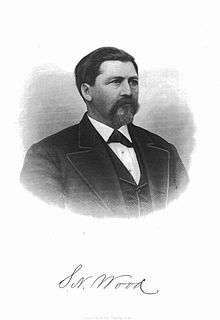Wakarusa War
The Wakarusa War was a skirmish that took place in Kansas Territory during November and December 1855 as part of the "Bleeding Kansas" violence between Free-Staters and pro-slavery militias. It centered on Lawrence, Kansas, and the Wakarusa River Valley.
Background

While pro- and anti-slavery settlers had held negative opinions of one another for some time, the genesis of the Wakarusa War in particular dates to November 21, 1855, when the pro-slavery settler Franklin Coleman shot the Free-Stater Charles Dow nine times in the back, killing him. The murder was the culmination of a long-simmering feud between the two, as for some time they had argued about a land claim near Hickory Point, located about 14 miles (23 km) south of Lawrence.[1] According to the Border War Encyclopedia, "Politics had not motivated Coleman to kill Dow, but the murder marked the genesis of the violent political divisions that characterized Kansas for the next 10 years."[2]
Coleman argued that he had been acting in self-defense when he killed Dow, and so when Douglas County Sheriff Samuel J. Jones investigated, he chose to arrest Dow's Free-State affiliate, Jacob Branson, for disturbing the peace.[3] Branson, however, was eventually rescued by Free-Staters, led by Samuel Newitt Wood, which caused the pro-slavery faction to seethe with anger.[4] Within a matter of days, the governor of the Kansas Territory, Wilson Shannon, called for the Kansas militia to settle the issue; Shannon had intended for the militia to be composed of Kansans, but Jones rallied a small army of 1,500 men, almost all of whom were from Missouri.[3][5] This group, led by Jones, crossed the Kansas border and made their way to Lawrence, preparing to eradicate the Free-Staters.[2][5]
Siege
.jpg)
During the siege, the main body of the invaders were encamped near the small pro-slavery settlement Franklin, located to the southeast of Lawrence, although others camped near the territorial capital of Lecompton.[5] The invading army was indifferently armed as a whole, but some men had broken into the United States Arsenal at Liberty, Missouri and stolen guns, cutlasses, the "Old Sacramento Cannon" (which would later be used during the Sacking of Lawrence in 1856), and other munitions of war.[2][6][7]
Hearing of the impending raid, the men of Lawrence raised up a militia of 800 men. Dr. Charles L. Robinson (an agent of the New England Emigrant Aid Company) was put in charge of the city's troops, and the future state senator James Lane was appointed as his second-in-command. Lawrence was also aided by the abolitionist John Brown and his sons. After about a week, the Free-Staters eventually sent an emissary to Shannon, who was briefed in regards to the situation. The news distressed him, so he journeyed to Lawrence to see the situation for himself and was quite startled by what he saw. He immediately called representatives from the Missouri army and Lawrence militia before him and urged them to sign a peace treaty.[2] Such an agreement was finally made in December 1855 between Robinson and Lane (who represented the Free-Staters) and David Rice Atchison (who represented the pro-slavers). After much persuasion (which, according to Frank W. Blackmar, "was not easily accomplished"), the Missouri army reluctantly left the area.[2][5]
Aside from Dow, the Wakarusa War claimed only one other life: that of Free State settler and abolitionist Thomas Barber, who, on his way to the defense of Lawrence, had been shot by the Pottawatomi Indian Agent George W. Clarke during an ambush. Barber's death was memorialized in a poem by John Greenleaf Whittier titled Burial of Barber.[2]
See also
References
- Litteer, Leron (1987). 'Bleeding Kansas': The Border War in Douglas and Adjacent Counties. Baldwin City, KS: Champion Publishing. pp. 4–7.
- Mullis, Tony. "Wakarusa War". Civil War on the Western Border: The Missouri-Kansas Conflict, 1854–1865. Retrieved Sep 5, 2015.
- Litteer, Leron (1987). 'Bleeding Kansas': The Border War in Douglas and Adjacent Counties. Baldwin City, KS: Champion Publishing. p. 13–14.
- Bisel, Debra Goodrich (2012). The Civil War in Kansas: Ten Years of Turmoil. Charleston, SC: The History Press. pp. 55–56. ISBN 9781609495633.
- "Wakarusa War – KS-Cyclopedia – 1912". Skyways.Lib.KS.us. Archived from the original on May 12, 2012. Retrieved May 21, 2012.
- History of Clay and Platte Counties, Missouri. St. Louis: National Historical Company. 1885. p. 174.
- Butler, Maria. "Old Sacramento: Cannon of Crisis, Cannon of Freedom" (PDF). Douglas County Historical Society Newsletter. 27 (3): 2, 4.